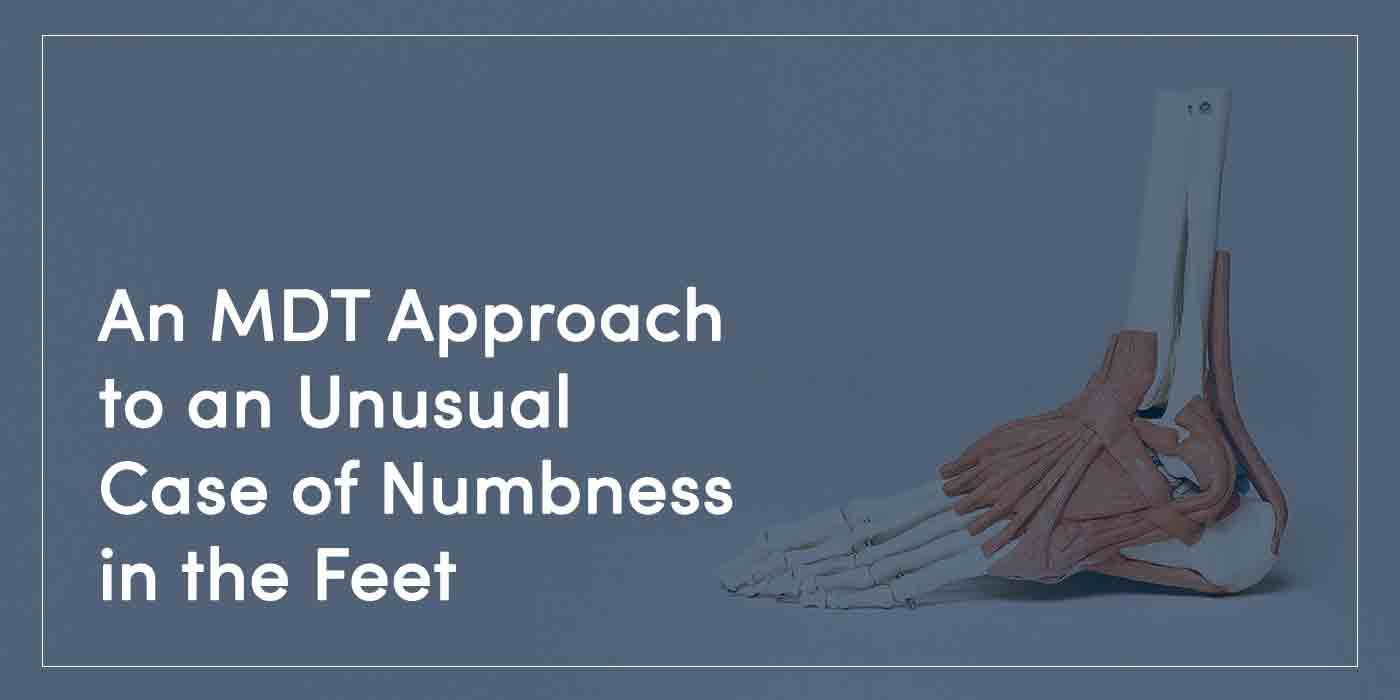An MDT Approach to an Unusual Case of Numbness in the Feet

Case of the Week
Introduction
This Clinical Insight article outlines a multi-disciplinary team approach to an unusual case of numbness in the feet.
Initial Presentation
A 55-year-old lady presented to the podiatry clinic concerned about symptoms of numbness affecting both 4 & 5th toes and the lateral borders of both feet. There was no significant medical history to suggest peripheral neuropathy.
The patient had previously seen her GP and a range of tests had not indicated any underlying medical conditions including multiple sclerosis, diabetes, folate or B12 deficiency.
The patient was a non-smoker and denied regular intake of alcohol, over-the-counter medicines, nor recreational drug use. Her symptoms had been present for over four years.
In 2019 a nerve conduction study revealed no weakness and no evidence of generalised large fibre damage. Needle EMG did show some chronic neurogenic changes for right tibialis anterior and right lateral gastrocnemius.
However, owing to limitations associated with Covid-19 no follow-up had been possible. Notably the patient had a 4-year history of hamstring tendinopathy over the ischial tuberosity bilaterally together with bursitis, confirmed by ultrasound imaging.
Previous treatment and rehabilitation consisted of a lot of stretching of the hamstrings and gluteals, shockwave therapy, dry needling and a heavy hamstring loading programme.
The patient questioned if her tendinopathy could be linked to the numbness in her feet. The patient reported a loss of her normal activities of daily living, particularly driving, and was finding sitting uncomfortable; her general mood was also reportedly low.
Her goals were to know why the pain in the posterior thigh keeps happening, to be able to sit on a chair more comfortably and move with less pain, to return to her chosen activities including gym work and Pilates.
Initial assessments by podiatry revealed no vascular abnormality and neurological tests revealed no frank sensory neuropathy or motor deficit. Importantly there were no features suggesting cauda equina syndrome. The patient did have an idiopathic hypermobile cavoid (high-arched) foot type with muscular ankle equinus.
Multi-disciplinary Approach
In consultation with neurological physiotherapy and radiology, the worsening symptoms together with the previous nerve conduction findings, a lumber spine MRI was requested to exclude the cause of her numbness from this region given the symptoms and nerve conduction study findings.
Separately, a shared consultation with sports rehabilitation was undertaken to review the hamstring problem in greater depth and consider a rehabilitation plan, mindful of the on-going foot numbness and previous positive nerve conduction studies.
Investigations
MRI reporting from our imaging team revealed mild degenerative changes and disc herniation together with foraminal narrowing with possible nerve root irritation at multiple levels across L1-S1, but no excessive narrowing causing nerve root compression.
Strength testing using equipment in gym and dynamometry significantly showed reduced strength in the hamstrings bilaterally but also more generally in the lower limb.
Management Plan
The patient presented with a history of bilateral proximal hamstring tendinopathy and bursitis as well as history of nerve root irritation as demonstrated by MRI.
The latter, together with her foot mechanics being the most likely reason for experiencing numbness in her feet. The patient returned to podiatry for orthotics to improve her overall foot function and off-load areas that were experiencing biomechanical overload, together with simple calf stretching to improve the ankle equinus.
Education on tendinopathies and their management, significantly reducing stretching and progressively loading the hamstring, while avoiding aggravating factors to minimise exacerbation of symptoms, was undertaken.
An overall lower limb strengthening programme was implemented that included progressively loading hamstrings, unilateral work, cross trainer rather than running, addressing complex movement patterns and breathing. Sessions were completed three to four times per week.
We retested strength at four weeks and noted significant improvement in lower limb strength as well as improving hamstring strength. Reduction in pain on sitting, moving and exercise was reported. Importantly, an ability to achieve higher functional levels, improvement in sleep and an enjoyment of exercise led to an increase in morale and motivation.
Outcome
After two months, significant improvement in mood, function, sitting and pain were evident, although not all symptoms fully resolved. The patient felt confident to self-manage with continued exercise and awareness.
Reflection
This Clinical Insight highlights the value of interdisciplinary management across different professions. It was important to alter the tissue dynamics – specifically using a loadbased rehabilitation plan, rather than focus on stretching.
Improved outcomes were dependent on good investigations and explanations/education. Importantly, being co-located allowed professionals to come together quickly to devise an appropriate plan to investigate the presenting features and rule our serious and/or systemic pathology.
In addition, management planning was facilitated by being able to co-ordinate and plan appointments to enable effective rehabilitation. This broader interdisciplinary approach led to improved quality of life for the patient, as we sought a patient-centred approach to maximise a holistic connections to care.